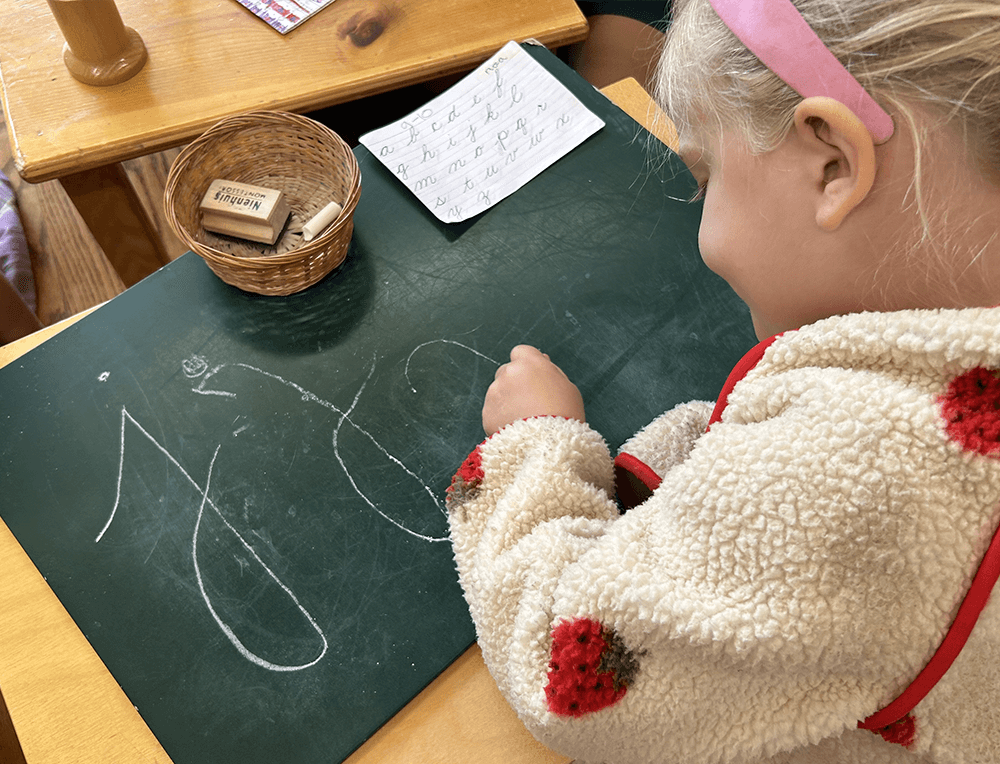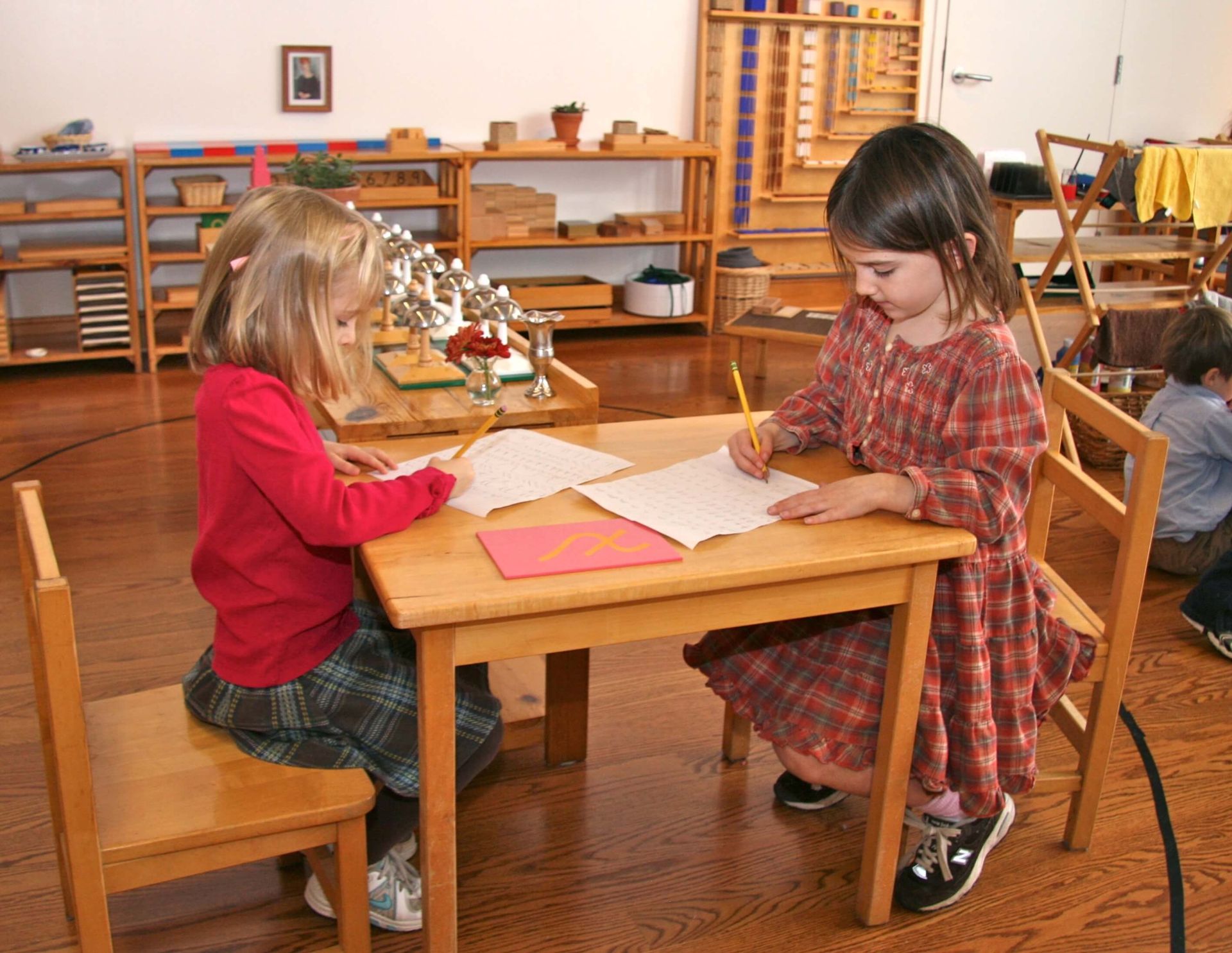
When Dr. Maria Montessori first introduced her method of education over one hundred years ago, her adherence to cursive handwriting for children was widely accepted by the culture. However, in the last several decades, as computer usage has swept across the globe, parents and educators began to focus more on print and technology itself for the expression of ideas and the retention of knowledge. Since then, Montessori’s commitment to cursive has seemed archaic, rigid, and unnecessary to critics and doubters. After all, why would children need to learn a type of handwriting that is becoming outdated? And what is the purpose of longhand writing when typing is much faster, and when print is readily available and integrates easily with books, articles, and the computer?
Montessori teachers and trainers have long argued for the importance of learning to read and write cursive before reading and writing in print—and for the importance of continuing to primarily use cursive in educational settings instead of resorting to typing and technology. But it is only in the last decade that research on longhand writing has established that it is superior to the use of technology for writing and learning. While research on cursive versus print has not yet established a clear preference for cursive in direct comparisons, much of the research comparing handwriting versus computers utilizes cursive specifically. Montessori theory holds that longhand writing has a unique value, and there is a general theory that we should not be so quick to assume that newer, faster ways of doing things are always better than the old-fashioned ways!
Montessori Theory on Cursive Versus Print
Easier to Learn Letters
While many adults assume that cursive is harder to learn because it is more complicated than print, Montessori educators believe that cursive is easier to learn precisely because it is more complicated than print. Print letters do not vary as widely from each other and are made up of the same general shapes—straight lines and near perfect circles. Cursive letters are more easily distinguished, with more directionality in the lines, curves, and distinct markings of each letter. For example, children can quickly decipher the difference between an “i” and a “j” in cursive, or an “r” and an “n.” Similarly, because the letters are more distinct, there is less of a chance of letter reversal confusion in cursive. A “b” and a “d” are much more distinct, as are “p” and “q.” All of this allows children to learn the names and shapes of the alphabet more quickly when they begin first with cursive.
Easier to Master the Formation of Letters
Many adults also believe that cursive letters are harder to produce than print letters. After all, print letters are primarily straight lines and complete or partial circles. However, Montessori theory maintains that straight lines and perfect circles are harder for children to produce precisely—both the marks themselves, as well as the way they need to join together to make letters. Cursive is considered easier because there is more room for error in the production of readable letters. Therefore, a child can more quickly reach the stage of writing legible letters in cursive rather than print, where they will need to have greater mastery of their hands before their writing will be readable.
Spaces Between Words Leads to Greater Comprehension
The letters in a word written in cursive are connected to one another, and words are separated by spaces. These clear delineations make it more straightforward for a young reader to isolate the words in a sentence. It also simplifies the writing process, as children understand how to form separate words when they are writing. This aids in their absorption of the organization of language and allows their writing to be understandable sooner.
Continuous, Natural Movement
Cursive writing only requires the pen or pencil to be lifted off the page after each individual word. Print writing requires the writing instrument to be lifted off the page many times, even within the writing of a single word. Montessori educators theorize that this interrupted movement pattern is harder on the creative and expressive properties of the brain. A child will more easily enter a state of concentrated flow when their hand is able to move smoothly and freely with their thoughts and is not continually interrupted by tiny movements.
Montessori Theory on Handwriting Versus Technology
It will come as no surprise to anyone familiar with the Montessori methodology that educators value handwriting over the use of the computer for both learning and for the expression of ideas. For learning, the benefits of handwriting cascade throughout a child’s educational experience: They are able to retain their letters more readily when they can physically move their fingers and hands to make the shapes. They are able to better understand the organization of their language when they are physically creating sentences and paragraphs. They are able to more thoroughly comprehend the information they are learning and working with when they have to form the letters and words by their own hand.
For the expression of ideas, Montessori has always prioritized the utilization of the mind and body in unison for meaningful work. When the hand and body are able to move freely with the activity of the mind, the entire person becomes integrated and fully absorbed in the activity. A computer reduces the expression of thought into the almost indistinguishable tapping of fingers, with the production of the work several inches away from the movement of the body. Only handwriting authentically integrates the hand’s specific efforts with the output of work and expression, leading to a thoroughly engaged activity.
What the Research Shows: Handwriting Versus Computers
Better Recall of Words and Letters for Emerging Readers
Research from 2020 indicates that when children write with pencil and paper, they more quickly and easily learn and retain letters and words, when compared to using a computer and compared to using a tablet and stylus. This study suggests that not only utilizing the fingers and hand in the motions of handwriting lead to greater retention of the shapes and and words, but that the unique experience of using a pencil and paper also adds to the benefit. This argument implies that the fine motor skills required for a pencil and paper, and perhaps the experience of the friction of the pencil and paper, uniquely unite the hand and regions of the brain necessary for language development (Mayer et al, 2020).
Retention of Information and Greater Conceptual Knowledge
A 2014 study examined the differences between students who took notes in a classroom in cursive versus on their laptop. While previous studies had considered whether the laptop itself caused issues with distraction, this one more closely considered whether simply the action of typing produced measurable differences when compared to recording notes in longhand. This particular study showed that students who used cursive in class performed better on exams that tested conceptual knowledge of the content. The researchers theorized that the process of converting the information to handwritten notes allowed for a more thorough processing of the information (Mueller & Oppenheimer, 2014). This indicates that cursive allows learners to retain more of the information that they receive, as well as gain a deeper understanding of the knowledge, when compared to typing.
Broader Brain Activation, Leading to Deeper Processing
A subsequent 2020 study used EEG scans to record the neural differences in older children and young adults who used cursive or typing in learning contexts. The scans showed that, indeed, the participants who were asked to use cursive in their work had greater areas of activation in their brain than those who used a computer. These findings state that broad brain activation allows for deeper processing and greater retention and understanding of academic material, thereby supporting the 2014 researchers’ hypothesis (Askvik, van der Weel, and van der Meer, 2020). Among other advantages, van der Meer shares that this is likely why children who learn to write by hand instead of typing are less likely to have issues with letter reversals (“b” versus “d”, etc). As Montessori suggests, engaging in activity that utilizes more of the brain appears to lead to more comprehension and greater recall of information on both a micro and macro level.
Final Thoughts
Montessori’s loyalty to longhand is based in a theory created from observations about how children learn. While incorporation of new technologies is an essential element of education at age appropriate times, there are important reasons for continuing to utilize a form of expression that has worked successfully for hundreds of years. It is necessary to consider new ideas! But when we are quick to leave behind methods that work, we also often leave behind benefits and skills that we did not realize were attached to those methods.
Schools across the country are re-introducing cursive into the curriculum, as they see the losses of the last decade during a rush to digitize learning. Students are struggling with learning to read and write, concentration, and retention and comprehension of material. There are many theories as to why this is the case. But as more studies come out showing the benefits of handwriting (usually cursive specifically) over technology, it is clear that when we lose handwriting, we lose more than just handwriting.
It may seem old-fashioned, but there are clear advantages to doing things the long way—the harder way. And our children should be the last group we experiment with by converting the method by which they are learning and expressing themselves too quickly. As our world becomes more and more digitized, let’s not rush to digitize our children’s education at the expense of their education. Let’s let them use as much of their bodies as they can when they learn so that they can also use as much of their minds as they can too.
Note: This post considers the educational experience of children who are neurotypical.
References
Askvik, E. O., van der Weel, F. R., & van der Meer, A. L. H. (2020). The importance of cursive handwriting over typewriting for learning in the classroom: A high-density EEG study of 12-year-old children and young adults. Frontiers in Psychology, 11, 1810. https://doi.org/10.3389/fpsyg.2020.01810
Mueller, P. A., & Oppenheimer, D. M. (2014). The pen is mightier than the keyboard: Advantages of longhand over laptop note taking. Psychological Science, 25(6), 1159-1168. https://doi.org/10.1177/0956797614524581
Mayer, C., Wallner, S., Budde-Spengler, N., Braunert, S., Arndt, P. A., & Kiefer, M. (2020). Literacy training of kindergarten children with pencil, keyboard or tablet stylus: The influence of the writing tool on reading and writing performance at the letter and word level. Frontiers in Psychology, 10, 3054. https://doi.org/10.3389/fpsyg.2019.03054


